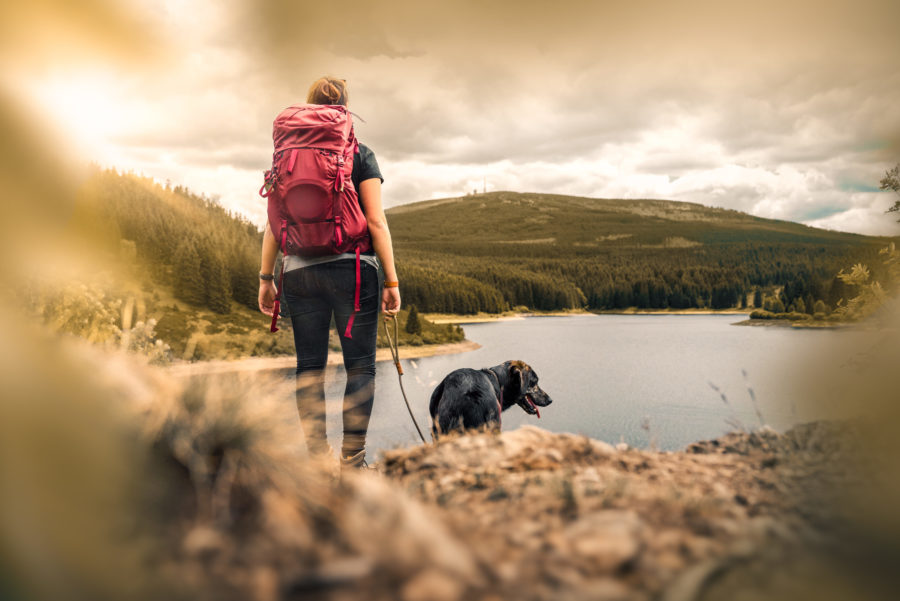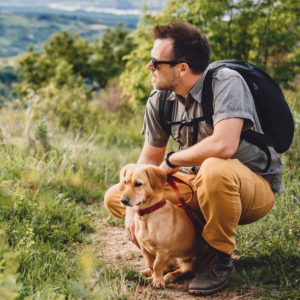
There’s no one better to accompany you on a hike than man’s best friend! Playful and often natural outdoor lovers, dogs are always ready and willing to go on an adventure and have a great attitude while doing it! Hiking isn’t made for all dogs, however, and there are a few items you’ll want to check off your list before taking your dog along on your next day’s hike.
#1: AGE
Dogs are a lot like humans in that they need time to develop and learn before doing the things they’ll be doing when they are adults. Nursing puppies should not be taken on hikes as they need to be close to their mothers and nursed often. The process of nursing is a developmental rite for puppies as it is for humans and deserves patience. Your dog will be ready for the trail sooner than you might think!
Also, use your best judgment in taking older dogs on the trail. Older dogs’ bones are often more susceptible to injury and may have increased sensitivity to temperature and inclement weather. Your older dog may thank you for leaving him/her snug at home.
#2: FITNESS AND SIZE
Taking your dog hiking when his/her normal daily activity is to sit in the shade of a tree and bark at other dogs is akin to you taking a hike when you sit around all day watching television. A dog’s level of fitness, like a human’s, is directly related to diet and nutrition. If your dog is fed well and receives daily exercise (sometimes twice a day) then most hikes won’t be out of its reach.
The size of your dog is also a factor. Small dogs can be great hikers especially if the trail isn’t steeply inclined but no matter how you look at it their little legs have to work a lot harder to travel a distance that a larger dog can cover in no time. Practice with walks around your neighborhood and be willing to introduce new trails to dogs in portions so that their bodies can become accustomed to the increased rigor of hiking.
#3: KNOW THE TRAIL
Before taking your dog on a trail it’s a good idea to get to know the trail yourself. If there are steep inclines, ladders, or precarious bridges on the trail it is probably best to leave your dog at home. Also, when hiking in national or state parks ensure that dogs are allowed on the trail(s) where you plan to hike.
#4: LEVEL OF TRAINING
Whether you are teaching a dog to sit, heel, balance on a ball, or do a backflip you’ve probably realized that many breeds of dogs can be trained to do amazing things! With the proper level of training, dogs can also learn to interact with humans in fairly sophisticated ways. When going on a hike dogs will need to be trained to keep a distance between children and strangers and even other dogs on the trail if possible. Dogs should also not bark on the trail as the sound can be disquieting for hikers who are looking for peace and tranquility.
You’ll want to keep your dog on a leash no longer than six feet (the extendable leashes aren’t recommended for the trail) and if you decide to remove the leash the dog should be trained to respond to all commands. Dogs should also be trained not to run or jump toward children or strangers or to bark as these actions can disturb or even frighten other hikers. Also, your dogs’ canine buddies should stay home for this one! When dogs get together they equal a pack and their pack mentality can cause havoc on the trail.
#5: HIKING PACKS FOR DOGS
In many cases, but not all, dogs are excellent carriers. Hiking packs for dogs should be fitted to the widest girth of your dog’s chest and should weigh no more than a third of the dog’s weight and perhaps less if you notice your dog struggling to carry the weight. In general, it is wise to fit a dog’s hiking pack several weeks before a hiking trip (including day trips) and allow the dog to become accustomed to it. Once the dog becomes accustomed feel free to add items to the pack and distribute all weight evenly on both sides of your dog’s chest. Increase the pack’s weight slightly day by day until the dog has become conditioned for his/her hiking experience.
#6: WATER
Dogs are just as susceptible to the parasite giardia as humans are and are not necessarily resilient to many additional bacterias or parasites found in water. On your next hike with your dog, make sure that you carry enough water-purifying products for both of you. Or maybe your dog can carry them for you in his/her pack!
#7: PAW PROTECTION
Many hikes include rough terrain. Rough terrain would include gravel, rocks, boulders, or sharp/poisonous verbiage. Do a bit of research on the terrain where you’ll be hiking. Is it appropriate for your dog’s paws? Paws can be easily cut by sharp edges and can also be severely burned when temperatures are high and their paws come in contact with rocks that have been in the sun for long periods of time.
Try to hike on trails that more often than not covered by soft leaves, soft needles, or packed/unpacked earth. Also, for heated conditions or small patches of rougher terrain invest in a pair of dog boots. Dog boots can look slightly ridiculous and your dog will more than likely need to wear them around the house or yard for a day or two before the hike to become accustomed to them but they will save you and your dog a lot of pain in terrain that often produces the unexpected. With dog boots, you may also have to experiment with various sizes. Your dog should be able to run and play in his/her dog boots.
Want to get your dog hiking gear? Want the best deal? Buy now!
#8: LIFE JACKETS
If the trail you will be hiking on follows swift rivers or other intimidating bodies of water remember that most dogs are not Olympian swimmers! Even dogs need life jackets in extreme conditions and dog life jackets, like their hiking packs, should be fitted before hiking to the widest girth of the dog’s chest.
#9: WASTE
When your dog takes a potty break on the trail it’s proper trail etiquette on day hikes to cart the waste out of the area and dispose of it elsewhere. Dog waste is not considered to be a natural part of a wild environment. If at any time you decide to extend your day-long hike to two days or more then adhere to the Leave No Trace (LNT) principles of disposing of waste.
#10: ENJOY
Take time to enjoy your dog’s company. Dogs offer a sense of complete loyalty and playfulness that isn’t always easy to find in your human companions! Appreciate and enjoy your four-legged fans!

